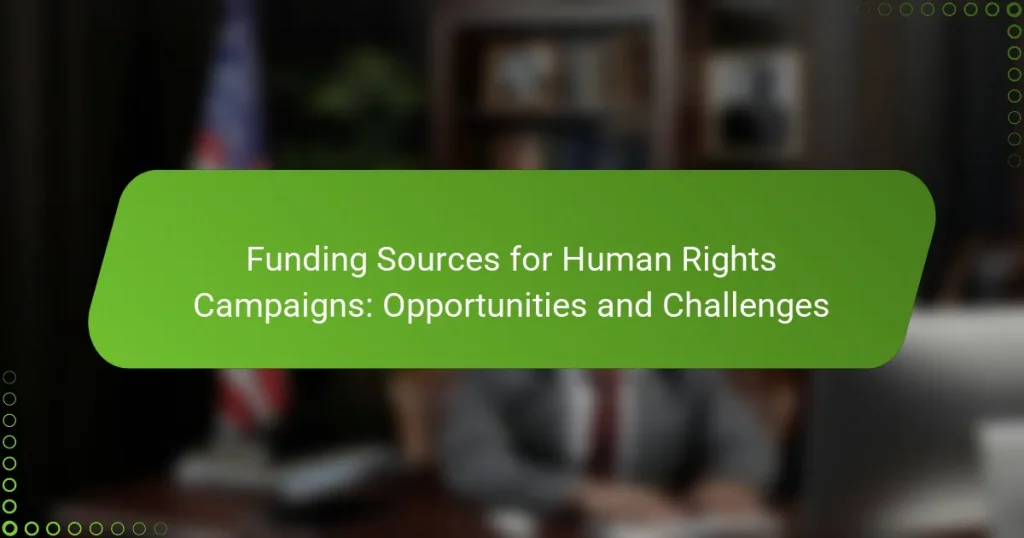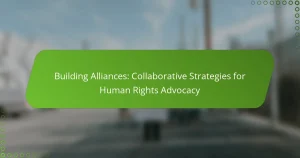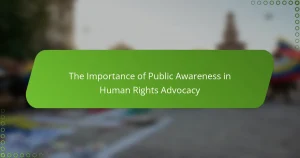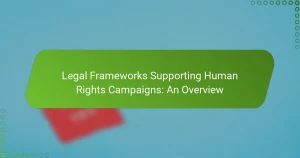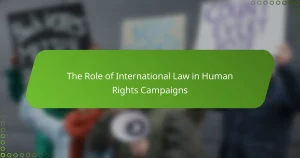Funding sources for human rights campaigns include government grants, private foundations, individual donations, and corporate sponsorships. These funding avenues are essential for sustaining initiatives that address global human rights challenges. Organizations face difficulties in securing funding due to inconsistent donor interest, competition for resources, and the perception of risk associated with human rights work. Additionally, demonstrating measurable outcomes poses challenges for many organizations. Emerging trends such as digital fundraising, collaborative funding models, and impact investing are reshaping the funding landscape, indicating a shift in strategies within the human rights sector.
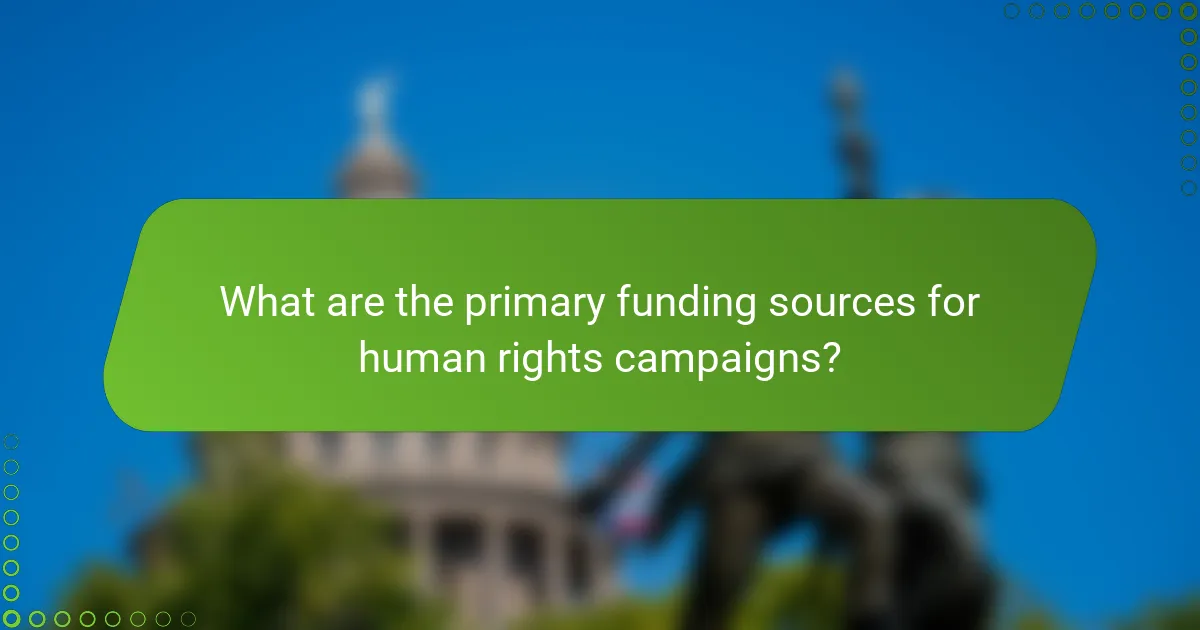
What are the primary funding sources for human rights campaigns?
The primary funding sources for human rights campaigns include government grants, private foundations, individual donations, and corporate sponsorships. Government grants often come from national and international bodies dedicated to promoting human rights. Private foundations typically allocate funds to specific projects aligned with their mission. Individual donations play a crucial role in grassroots campaigns, providing direct support from the community. Corporate sponsorships can offer financial resources while enhancing a company’s social responsibility image. According to the Human Rights Funders Network, these diverse funding sources are essential for sustaining human rights initiatives and addressing various global challenges.
How do government grants support human rights initiatives?
Government grants support human rights initiatives by providing essential funding for projects and organizations. These grants enable groups to conduct research, raise awareness, and advocate for policy changes. For example, the U.S. government allocates funds through the Bureau of Democracy, Human Rights, and Labor. This funding supports programs that promote civil society and protect human rights defenders. Additionally, grants can help finance legal assistance for victims of human rights abuses. According to the National Endowment for Democracy, government grants have funded over 900 human rights projects worldwide. This financial support is critical for sustaining long-term human rights efforts.
What criteria must organizations meet to qualify for government funding?
Organizations must demonstrate compliance with specific eligibility criteria to qualify for government funding. These criteria often include having a clear mission aligned with government priorities. Organizations must also provide detailed financial records and demonstrate sound financial management practices. Additionally, they must have a defined project plan with measurable outcomes. Many funding programs require organizations to show community support or partnership involvement. Organizations must also comply with applicable laws and regulations, including non-discrimination policies. Finally, they may need to demonstrate previous experience in managing similar projects successfully. Meeting these criteria increases the likelihood of receiving government funding.
How do government funding processes vary by country?
Government funding processes vary significantly by country. In some countries, funding is centralized and managed by national agencies. For example, countries like France allocate funds through a national budget process. Other countries, such as the United States, have decentralized funding, where state and local governments also play significant roles. In these cases, funding decisions may vary widely by region.
Additionally, some nations prioritize specific sectors for funding, such as education or healthcare, while others may have more flexible funding criteria. Transparency and accountability in funding processes also differ; countries like Sweden emphasize public access to funding information. In contrast, some nations may have less stringent transparency requirements.
Moreover, the criteria for eligibility and application processes can differ greatly. For instance, in Germany, non-profit organizations often receive direct funding, while in the UK, funding may be contingent upon competitive grant applications. These variations reflect each country’s political, economic, and social contexts.
What role do private donations play in funding human rights campaigns?
Private donations are crucial for funding human rights campaigns. They provide essential financial resources that enable organizations to operate effectively. Many human rights initiatives rely heavily on these contributions to support their programs and advocacy efforts. For instance, private donations can fund legal assistance, public awareness campaigns, and grassroots mobilization. According to a report by Human Rights Watch, private funding accounted for approximately 40% of total funding for many human rights organizations in 2020. This financial support allows these organizations to respond swiftly to human rights abuses and promote social justice. Additionally, private donations can help diversify funding sources, reducing reliance on government grants which may come with restrictions.
How can campaigns effectively engage individual donors?
Campaigns can effectively engage individual donors by personalizing communication and demonstrating impact. Personalized messages resonate better with donors, increasing their emotional connection. Regular updates about the campaign’s progress keep donors informed and involved. Transparency about how donations are used builds trust. Utilizing storytelling can illustrate the campaign’s mission and the difference donations make. Engaging donors through social media fosters community and encourages sharing. Offering recognition, such as donor spotlights, can enhance donor loyalty. Research shows that campaigns with strong donor engagement strategies see a 20% increase in retention rates.
What are the challenges of relying on private contributions?
Relying on private contributions poses several challenges for funding human rights campaigns. One significant issue is the unpredictability of funding. Private donations can fluctuate based on economic conditions or donor priorities. This inconsistency can lead to funding shortfalls, making it difficult to maintain ongoing initiatives.
Another challenge is the potential for donor influence. Private contributors may seek to shape campaign agendas or outcomes according to their interests. This can compromise the integrity of human rights efforts. Additionally, reliance on a limited number of donors can create vulnerability. If a major donor withdraws support, the campaign may face severe financial strain.
Transparency and accountability can also become issues. Donors may demand confidentiality or restrict how funds are used. This can hinder the campaign’s ability to operate openly and engage with the public. Furthermore, there is the risk of mission drift. Organizations may prioritize projects that attract funding over those that align with their core mission.
In summary, challenges include funding unpredictability, donor influence, vulnerability from limited sources, transparency issues, and potential mission drift. These factors can significantly impact the effectiveness and sustainability of human rights campaigns.
How do corporate sponsorships impact human rights initiatives?
Corporate sponsorships can significantly enhance human rights initiatives by providing essential funding and resources. These financial contributions enable organizations to expand their outreach and implement impactful programs. For example, companies often support awareness campaigns that address social injustices. This support can amplify the voices of marginalized communities. However, corporate involvement may also lead to potential conflicts of interest. Corporations might influence the agenda of human rights organizations to align with their branding. This could dilute the authenticity of the initiatives. Additionally, reliance on corporate funding can create vulnerabilities if sponsorships are withdrawn. Overall, while corporate sponsorships can boost human rights efforts, they also introduce complexities that must be navigated carefully.
What are the ethical considerations of corporate funding?
Corporate funding raises several ethical considerations. These include potential conflicts of interest, influence on decision-making, and the integrity of funded initiatives. Conflicts of interest occur when corporate sponsors have a vested interest in the outcomes of funded projects. This can compromise the objectivity of research or advocacy efforts.
Influence on decision-making can lead organizations to prioritize corporate interests over community needs. Funded organizations may feel pressured to align their goals with those of their sponsors. This can undermine the authenticity of their mission.
The integrity of initiatives can be at risk if funding comes with strings attached. Corporations may seek to shape narratives or outcomes that favor their brand. This can result in a lack of transparency and accountability.
Research shows that corporate influence can skew public policy and research agendas. A study by the Center for Media and Democracy found that corporate funding often leads to biased outcomes in research. These ethical considerations must be addressed to maintain trust and credibility in human rights campaigns.
How can campaigns balance corporate support with mission integrity?
Campaigns can balance corporate support with mission integrity by establishing clear guidelines for partnerships. These guidelines should align corporate values with the campaign’s mission. Transparency is essential in communicating the nature of corporate support to stakeholders. Regular evaluations of partnerships can ensure they remain aligned with the campaign’s goals. Engaging stakeholders in discussions about corporate involvement can foster trust. Campaigns can also prioritize partnerships with corporations that have a proven track record in social responsibility. This approach helps maintain mission integrity while benefiting from corporate resources. Research shows that successful campaigns often leverage corporate partnerships without compromising their core values.
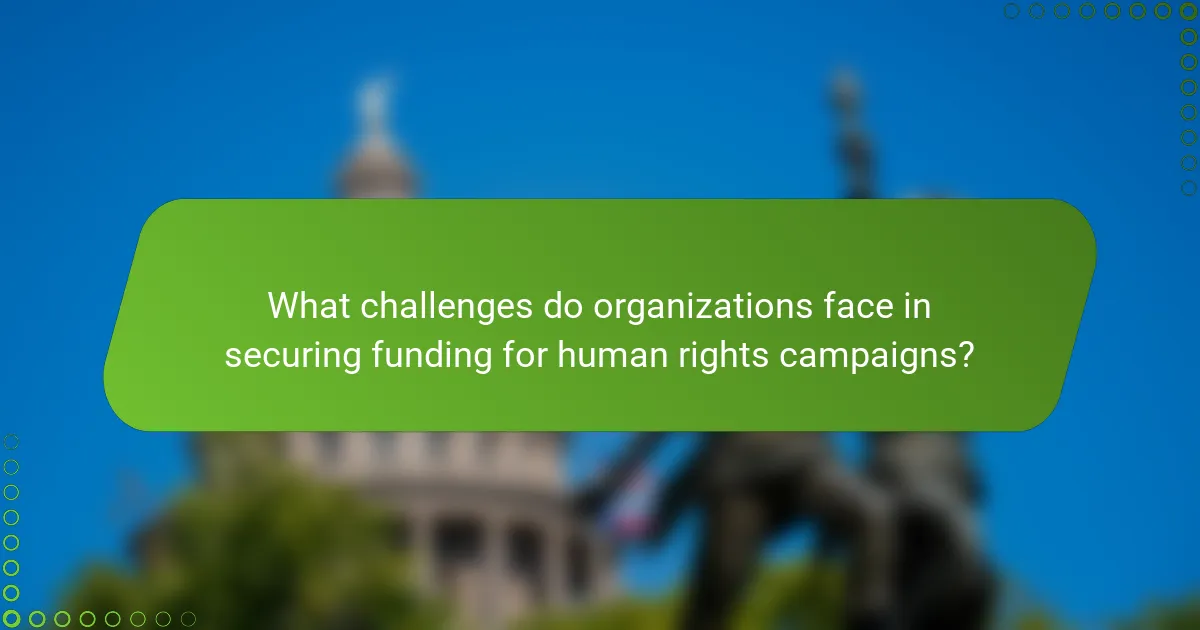
What challenges do organizations face in securing funding for human rights campaigns?
Organizations face several challenges in securing funding for human rights campaigns. A primary challenge is the lack of consistent donor interest. Many potential funders prioritize other issues over human rights, leading to limited financial resources. Additionally, organizations often struggle with competition for grants and donations. Numerous groups seek the same funding sources, making it difficult to stand out.
Another significant challenge is the perception of risk associated with human rights work. Donors may view funding human rights campaigns as politically sensitive or controversial. This perception can deter potential funders from supporting these initiatives. Furthermore, there is often a lack of understanding about the impact of human rights work. Funders may not fully grasp the importance of these campaigns, which can result in inadequate funding.
Lastly, many organizations face challenges in demonstrating measurable outcomes. Funders increasingly demand evidence of impact, and human rights work can be difficult to quantify. This difficulty in measurement can hinder funding opportunities. These challenges collectively create a complex landscape for organizations seeking funding for human rights campaigns.
What are the common barriers to accessing funding sources?
Common barriers to accessing funding sources include lack of awareness, limited networks, and stringent eligibility criteria. Many organizations are unaware of available funding opportunities. This lack of knowledge prevents them from applying. Limited networks can hinder access to potential funders. Organizations often rely on existing contacts, which may not include diverse funding sources. Stringent eligibility criteria can exclude many applicants. Funders may prioritize specific types of projects or demographics, leaving others without support. Additionally, bureaucratic processes can complicate application submissions. These barriers collectively restrict access to necessary funding for human rights campaigns.
How does political climate affect funding availability?
The political climate significantly affects funding availability for various initiatives. A supportive political environment often leads to increased funding from government sources and private donors. For instance, during administrations that prioritize human rights, funding for related campaigns tends to rise. Conversely, a hostile political climate can result in reduced funding opportunities. In such cases, donors may withdraw support due to perceived risks or unfavorable policies. Historical examples include fluctuations in funding for human rights organizations during different presidential administrations in the United States. These shifts illustrate how political priorities directly influence the financial landscape for campaigns.
What role does public perception play in funding challenges?
Public perception significantly influences funding challenges for human rights campaigns. Positive public perception can lead to increased donations and support from individuals and organizations. Conversely, negative perceptions can deter potential funders and result in reduced financial backing. Research indicates that campaigns perceived as credible and impactful attract more funding. For instance, a study by the Human Rights Funders Network found that campaigns with strong public engagement received 30% more funding than those with limited visibility. Thus, maintaining a favorable public image is crucial for securing financial resources in the human rights sector.
How can organizations overcome funding obstacles?
Organizations can overcome funding obstacles by diversifying their funding sources. They should seek grants from multiple foundations and government programs. Building partnerships with businesses can also provide additional financial support. Crowdfunding campaigns can engage the community and raise funds directly from supporters. Developing a strong online presence can attract individual donors. Utilizing social media for fundraising initiatives can increase visibility and contributions. Providing transparency about fund usage can build trust with potential donors. Lastly, organizations should continuously evaluate and adapt their funding strategies to meet changing circumstances.
What strategies can enhance funding applications?
Clear and concise funding applications enhance the chances of securing funding. Start by thoroughly researching potential funders to align your project with their priorities. Tailor your application to address specific funder guidelines and criteria. Utilize data and evidence to support your claims and demonstrate the impact of your project. Include a clear budget that outlines how funds will be used effectively. Engage stakeholders in the application process for diverse perspectives and support. Proofread for clarity and coherence to eliminate errors that may detract from your message. Following these strategies can significantly improve the quality and effectiveness of funding applications.
How can partnerships improve funding opportunities?
Partnerships can significantly improve funding opportunities by leveraging shared resources and networks. Collaborating with other organizations can enhance credibility and attract more funders. Joint initiatives often demonstrate a broader impact, appealing to grantmakers looking for scalable solutions. Additionally, partnerships can combine expertise, leading to more innovative project proposals. This collaboration can also lead to cost-sharing, which makes projects more financially viable. Funders often prefer to support initiatives that show collaboration and community engagement. A study by the National Council of Nonprofits found that organizations in partnerships are more likely to receive funding compared to those that operate independently. Therefore, partnerships can create a compelling case for funding by showcasing collective strength and shared goals.
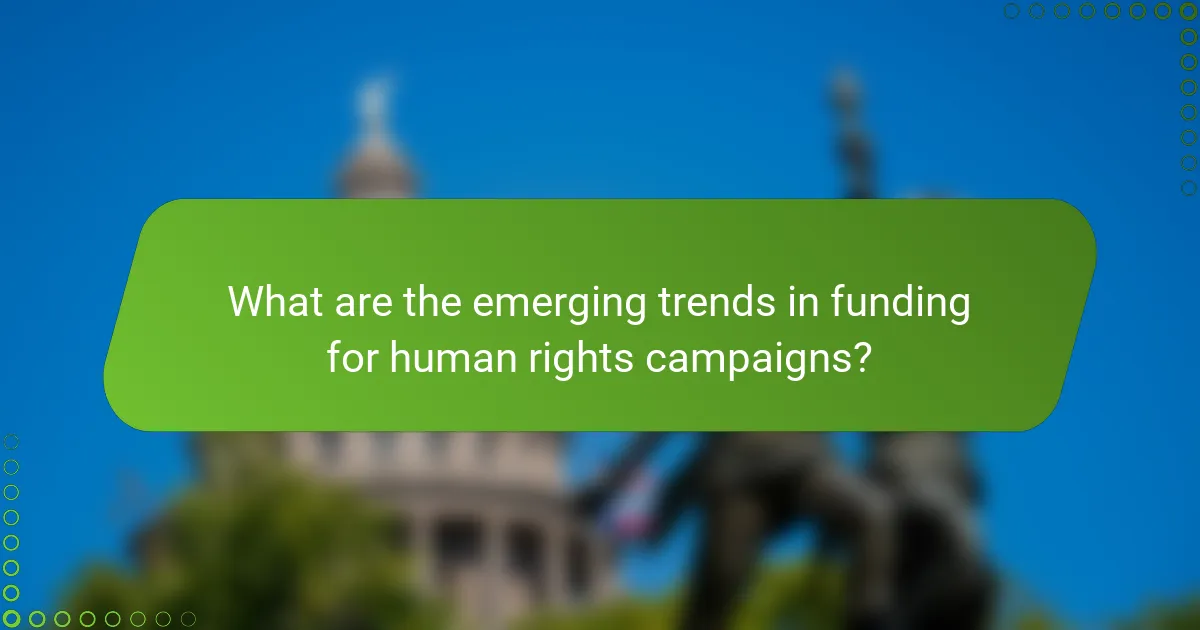
What are the emerging trends in funding for human rights campaigns?
Emerging trends in funding for human rights campaigns include increased reliance on digital fundraising platforms and crowdfunding. Organizations are leveraging social media to engage supporters and raise funds. This method allows for reaching a broader audience quickly and efficiently. Additionally, there is a shift towards collaborative funding models. Partnerships between NGOs and private sector companies are becoming more common. These collaborations can enhance resource sharing and innovative solutions. Furthermore, impact investing is gaining traction. Investors are looking for measurable social outcomes alongside financial returns. According to the 2022 Global Trends in Philanthropy report, 40% of surveyed organizations reported using digital platforms for fundraising. This indicates a significant shift in funding strategies within the human rights sector.
How is technology changing the landscape of fundraising for human rights?
Technology is transforming fundraising for human rights by increasing accessibility and enhancing engagement. Online platforms enable organizations to reach a global audience. Crowdfunding sites allow individuals to contribute directly to specific causes. Social media facilitates awareness campaigns and mobilizes supporters quickly. Data analytics helps organizations target potential donors more effectively. Mobile payment solutions simplify the donation process. Virtual events and webinars expand outreach without geographical limitations. According to a 2021 report by the Charities Aid Foundation, online donations surged by 30% during the pandemic, highlighting technology’s impact.
What digital platforms are most effective for fundraising?
Social media platforms like Facebook and Instagram are the most effective for fundraising. They allow organizations to reach large audiences quickly. Facebook’s fundraising tools enable direct donations and event promotions. Instagram supports visual storytelling, enhancing engagement and support. Crowdfunding sites like GoFundMe and Kickstarter also play a significant role. They provide dedicated spaces for fundraising campaigns. Research shows that social media campaigns can increase donations by up to 40%. Additionally, email marketing remains a strong channel for direct appeals. Studies indicate that personalized emails can yield a 29% higher response rate.
How can social media campaigns drive funding success?
Social media campaigns can drive funding success by increasing visibility and engagement with potential donors. They leverage platforms like Facebook, Twitter, and Instagram to reach a wider audience. These campaigns often utilize compelling storytelling to connect emotionally with supporters. Engaging content, such as videos and infographics, can enhance shareability and attract more attention.
Research shows that 54% of social media users are more likely to donate after seeing a cause shared online. Campaigns can also create a sense of community among supporters, fostering a culture of giving. Additionally, social media allows for real-time interaction, enabling organizations to respond to inquiries and build relationships.
Fundraising events promoted through social media can see increased attendance and contributions. Overall, effective social media strategies can significantly boost funding opportunities for human rights campaigns.
What innovative funding models are being adopted in the sector?
Innovative funding models in the human rights sector include crowdfunding, social impact bonds, and collaborative funding. Crowdfunding allows individuals to contribute small amounts, harnessing community support. Social impact bonds involve private investors funding social programs, repaid by the government based on achieved outcomes. Collaborative funding brings together multiple organizations to pool resources for shared objectives. These models are gaining traction as they provide flexible and diverse funding sources. According to the Human Rights Funders Network, these approaches increase financial sustainability and community engagement in human rights campaigns.
How does crowdfunding differ from traditional funding sources?
Crowdfunding differs from traditional funding sources primarily in its accessibility and method of raising capital. Crowdfunding allows individuals or organizations to raise small amounts of money from a large number of people, typically via online platforms. In contrast, traditional funding sources often involve larger sums from fewer entities, such as banks or venture capitalists.
Crowdfunding campaigns can be launched with minimal upfront costs and often require less stringent eligibility criteria. Traditional funding sources usually require detailed business plans and credit assessments. Crowdfunding also enables direct engagement with supporters, fostering community involvement. Traditional funding sources may lack this personal connection, focusing instead on financial metrics.
Evidence shows that crowdfunding has grown significantly, with platforms like Kickstarter raising over $5 billion since its inception in 2009. This demonstrates a shift towards democratized funding avenues.
What are the benefits of using social impact bonds for human rights?
Social impact bonds (SIBs) provide innovative funding for human rights initiatives. They enable upfront investment from private entities for social programs. Governments repay these investors based on measurable outcomes. This approach incentivizes effective interventions that promote human rights. SIBs can attract diverse funding sources, reducing reliance on traditional public funding. They also encourage collaboration between public, private, and nonprofit sectors. Evidence from programs in countries like the UK shows improved outcomes in areas such as homelessness and youth incarceration. Overall, SIBs align financial interests with social impact, fostering accountability and transparency in human rights funding.
What best practices should organizations follow to secure funding?
Organizations should establish clear goals and objectives to secure funding. Defining specific outcomes helps attract potential funders. They should also create a compelling narrative that communicates their mission. A strong story engages donors and illustrates the impact of their support. Building relationships with funders is crucial. Regular communication fosters trust and encourages ongoing support.
Organizations must also demonstrate transparency in financial reporting. Providing clear and accessible financial information reassures funders about responsible management. Additionally, they should diversify funding sources to reduce dependence on a single donor. This strategy minimizes risk and enhances sustainability. Lastly, organizations should actively seek feedback and adapt their strategies. Continuous improvement increases their appeal to funders and enhances long-term success.
How can organizations create compelling narratives for their campaigns?
Organizations can create compelling narratives for their campaigns by focusing on authenticity and emotional connection. They should clearly define their mission and values. This helps establish credibility and trust with the audience. Incorporating personal stories can enhance relatability. Statistics and facts can provide context and urgency. Visual elements like images and videos can engage the audience more effectively. Consistency across platforms reinforces the message. Research shows that emotionally driven campaigns can increase engagement by up to 300% (source: Nielsen).
What metrics should organizations track to demonstrate impact to funders?
Organizations should track metrics such as program reach, engagement levels, and outcome effectiveness to demonstrate impact to funders. Program reach quantifies the number of individuals or communities served. Engagement levels measure participant involvement and satisfaction with the programs. Outcome effectiveness assesses the tangible results achieved, such as changes in behavior or policy.
Additionally, tracking financial efficiency metrics, like cost per outcome, provides insights into resource utilization. Funders often look for data on long-term sustainability and scalability of initiatives. Evaluating qualitative feedback from beneficiaries can also highlight the program’s significance. Collectively, these metrics give a comprehensive view of an organization’s impact.
The main entity of this article is funding sources for human rights campaigns. The article examines various funding avenues, including government grants, private donations, and corporate sponsorships, highlighting their roles and challenges in supporting human rights initiatives. It discusses the criteria organizations must meet to secure government funding, the impact of individual donations, and the ethical considerations of corporate support. Additionally, it explores emerging trends in fundraising, such as digital platforms and innovative funding models like social impact bonds, while addressing common barriers organizations face in accessing financial resources. Overall, the article provides a comprehensive overview of the landscape of funding for human rights campaigns, emphasizing opportunities and challenges.
